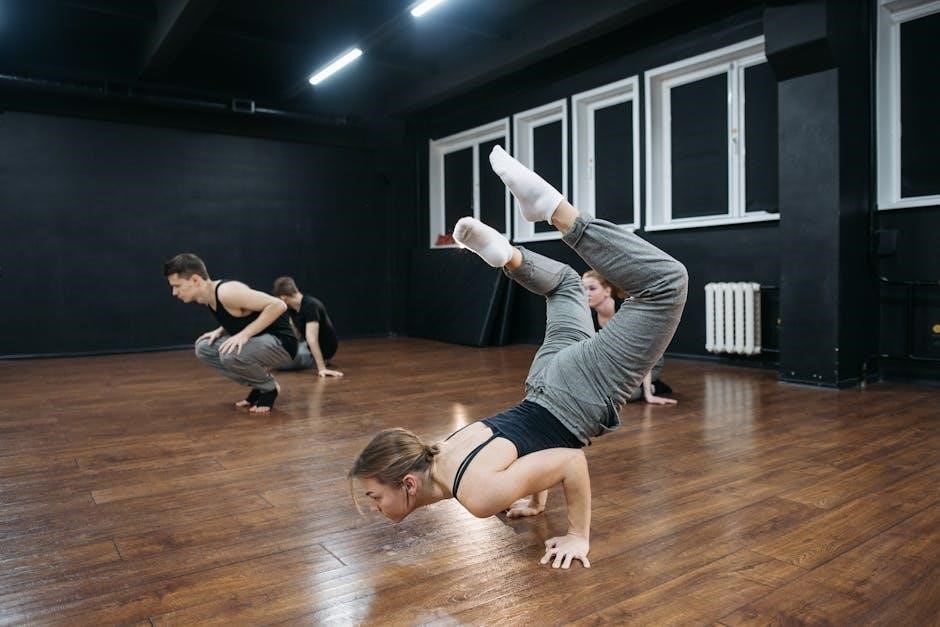Overcoming Gravity PDF: A Comprehensive Guide
Overcoming Gravity, often called an “exercise Bible,” is a comprehensive guide for gymnastics and bodyweight strength training. The PDF version offers a wealth of knowledge within its pages.
“Overcoming Gravity” is a comprehensive guide that provides a gold mine of information for gymnastics and bodyweight strength training. Penned by Steven Low, a physical therapist, it aims to bridge the gap between gymnast and recreational adult training methodologies. The book emphasizes a systematic approach, offering insights into exercise progressions, biomechanics, and programming. Whether you’re a seasoned athlete or just beginning your fitness journey, “Overcoming Gravity” provides the knowledge to understand how to program your workouts effectively. The PDF version makes this resource readily accessible for those seeking a deeper understanding of bodyweight training principles. It’s designed to defy the limitations of traditional training.
Understanding the Book’s Scope
The book “Overcoming Gravity” provides a systematic approach to gymnastics and bodyweight strength. It helps the user understand exercise progressions, programming and the adaptation of training for different levels.
Gymnastics and Bodyweight Strength Training
“Overcoming Gravity” focuses on gymnastics and bodyweight strength, offering a comprehensive resource in these areas. The book presents scientific principles applied to bodyweight exercises, helping readers understand the mechanics. It details the technique and progression of exercises and skills. It emphasizes a systematic approach, teaching users how to progress safely and effectively. The guide provides a gold mine of information, especially in areas like handstands and levers. Furthermore, the book differentiates the way you train a gymnast from the way you train a recreational adult. With this book, you can master bodyweight fitness and build strength.
A Systematic Approach
“Overcoming Gravity” emphasizes a systematic approach to gymnastics and bodyweight strength training. The book provides a structured methodology for exercise progression. By using this systematic approach, you can achieve long-term fitness goals. The book also teaches how to effectively program workouts. The author’s approach helps readers understand the concepts required to program their workouts effectively. This contrasts with many other resources, which often focus on isolated exercises. The book helps you understand the science behind training. This systematic framework allows individuals to adapt the training to their level. Finally, this approach allows recreational adults to benefit from gymnastics.

Key Concepts and Principles
The book Overcoming Gravity covers key concepts. These concepts are vital for understanding gymnastics training. It also explains the principles of bodyweight strength. The book provides a gold mine of information.
Exercise Progressions and Programming
Overcoming Gravity emphasizes structured exercise progressions. The book presents a systematic approach to gymnastics and bodyweight strength, guiding users through carefully designed steps to achieve mastery. Progressions are a cornerstone. They allow individuals of varying abilities to gradually increase exercise difficulty. Effective programming, as detailed in the PDF, is critical for maximizing results and minimizing injury risk. It teaches concepts required to understand how to program your workouts. The book provides sample programming, charts, and routines to aid users in creating personalized training plans. Understanding exercise progressions is key. They help to reach fitness goals safely and efficiently, with considerations for individual needs and limitations.
Understanding Levers and Biomechanics
Overcoming Gravity highlights the importance of levers and biomechanics in gymnastics and bodyweight training. The PDF explains how understanding these principles enhances training effectiveness and reduces injury. Biomechanics, the study of movement, informs optimal exercise execution. Understanding levers, which amplify force, is critical for progressing to advanced movements. The book’s systematic approach emphasizes proper form and technique based on biomechanical principles. This knowledge allows users to maximize strength gains. It also helps to refine movement patterns; By applying biomechanical concepts, individuals can optimize their training routines. This leads to improved performance and minimizes the risk of developing compensatory movement patterns and injuries. This helps to reach fitness goals.
Content of the “Overcoming Gravity” PDF
The “Overcoming Gravity” PDF contains comprehensive exercise charts, detailed progressions, and sample programming routines. These resources are crucial for effectively implementing the book’s systematic approach to training.
Exercise Charts and Progressions
The “Overcoming Gravity” PDF offers detailed exercise charts that visually represent progressions for various bodyweight movements. These charts are essential for understanding the levels, regressions, and progressions associated with each exercise. They provide a clear pathway for advancing from beginner to advanced skills. Each chart specifies the muscles emphasized during each movement, aiding in targeted training. The progressions are carefully structured, allowing users to gradually increase difficulty and build strength and skill safely. Abbreviations and legends explain the terminology used within the charts. These visual aids are indispensable for planning and tracking progress within a bodyweight training program.
Sample Programming and Routines
The “Overcoming Gravity” PDF includes sample programming and routines designed to provide a structured approach to bodyweight training. These routines are invaluable for those seeking guidance on how to combine exercises effectively. The sample programs demonstrate how to apply the principles of progression and overload. They can be adapted to suit individual fitness levels and goals; These routines often incorporate dynamic warm-ups, bodyline drills, and targeted exercises; Users can modify the programs by adjusting exercise selection, sets, reps, and rest periods. The routines serve as a practical starting point for developing personalized training plans focused on strength, skill development, and overall fitness.

Where to Find “Overcoming Gravity” PDF
The official source for the “Overcoming Gravity” PDF is Steven Low’s online store (stevenlow.org). It is also available, along with the physical book, on Amazon.
Official Online Store (stevenlow.org)
The most reliable and ethical way to obtain the “Overcoming Gravity” PDF is through Steven Low’s official online store, accessible via stevenlow.org. Purchasing directly from the author ensures you receive a legitimate, DRM-free copy of the book. This supports the author’s work and allows for continued updates and resources. The store provides both PDF and ePUB versions, offering flexibility for different devices. It guarantees you are getting the complete and unaltered content, including all exercise charts and programming routines.
Pirated Versions and Ethical Considerations
While pirated versions of the “Overcoming Gravity” PDF may be found online, downloading them raises significant ethical concerns. Obtaining the book through unofficial channels deprives the author, Steven Low, of deserved compensation for his extensive work and expertise. This undermines his ability to continue creating valuable resources for the fitness community. Furthermore, pirated copies may contain incomplete or altered content, potentially leading to misinformation or even malware risks. Supporting the author through legitimate purchase ensures the continued availability and integrity of “Overcoming Gravity.”

Target Audience and Training Methodology
Overcoming Gravity’s training approach adapts to different individuals, from gymnasts to recreational adults. The methodology emphasizes understanding individual needs and tailoring training programs accordingly.
Gymnasts vs. Recreational Adults
The training methodologies for gymnasts and recreational adults differ significantly, even when pursuing similar bodyweight skills. Overcoming Gravity acknowledges this disparity. The way you train a gymnast is not the way you train a recreational adult interested in the same material.
Gymnasts often require highly specialized training focusing on specific skills and competition preparation. Recreational adults, conversely, may prioritize general fitness, strength development, and injury prevention. Overcoming Gravity helps in understanding the specific needs of each group.
Adapting the program ensures both groups can safely and effectively progress toward their goals, whether it’s mastering advanced gymnastic movements or simply improving overall fitness.
Adapting Training for Different Levels
Overcoming Gravity emphasizes the importance of tailoring training programs to individual skill levels and experience. Beginners should focus on fundamental movements and building a solid foundation before progressing to more advanced exercises.
The book’s exercise charts and progressions provide a structured pathway for individuals of all levels, from novice to advanced. By starting with easier variations and gradually increasing the difficulty, users can minimize the risk of injury and maximize their progress.
Understanding one’s current capabilities and adjusting the training intensity and volume accordingly is crucial for achieving sustainable results and avoiding plateaus. The comprehensive approach allows for personalized adaptation.

Additional Resources and Charts
The Overcoming Gravity PDF provides valuable charts for exercises like handstands, pulling, and pushing movements. These resources detail progressions, levels, and relevant muscles targeted within the training program.
Handstand Chart
The Overcoming Gravity PDF includes a detailed handstand chart, outlining progressions for achieving and maintaining a stable handstand. This chart emphasizes muscles like anterior deltoids, traps, and triceps, crucial for body control. Exercises include headstand pushups. Abbreviations like BW (Body Weight) and R (Rings) are used within the chart. The chart differentiates between straight-body handstands and other variations. It also highlights the importance of posterior deltoids and back muscles for L-sits, V-sits, and Manna progressions. This resource serves as a guide for improving handstand skill.
Pulling and Pushing Exercises Chart
The Overcoming Gravity PDF provides comprehensive charts for pulling and pushing exercises, essential components of bodyweight strength training. These charts detail progressions, starting from beginner levels and advancing to more complex movements. These charts help users understand the exercise levels. Exercises use abbreviations such as BW (body weight). The charts helps the user to progress. Pulling exercises may include rows and pull-ups. Pushing exercises may include push-ups and dips. These resources serve as valuable tools for structuring a well-rounded calisthenics routine, promoting balanced muscular development and overall strength gains.






